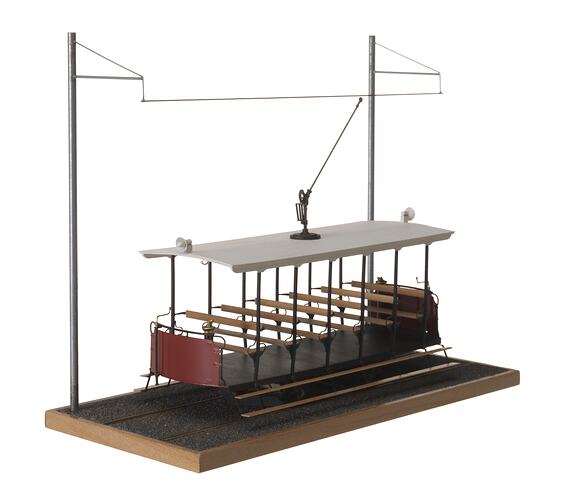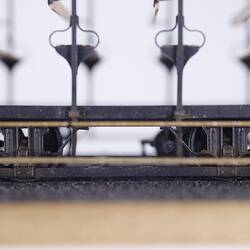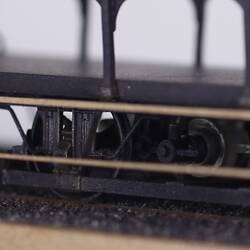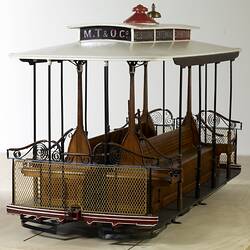Summary
Scale model of the first electric-powered tram in Melbourne, which operated intermittently from 1888 to the mid-1890s. Model scale: 1:48 (1/4-inch to the foot).
The model was commissioned by Museum Victoria in 2013 for the Transport Collection and is featured in the Transport Showcase in the Scienceworks Think Ahead Exhibition. It was constructed by model maker, Mark O'Brien. The model depicts the tram as it is believed to have looked when first operating on the Box Hill & Doncaster Tramway Company's street railway in 1889. The model was fabricated by first constructing a digital 3D CAD model of the original tram based on historic photographs, drawings and other documentation. Components were then 3D printed in plastic, hand-painted in the original colour scheme and assembled by hand using adhesive.
The Thomson-Houston electric tramcar, on which this model has been based, was first exhibited as a visitor attraction at the 1888 International Exhibition in Melbourne by W. H. Masters and Company. The 1888 Centennial Exhibition provided an opportunity for Masters and Company to promote the latest overseas developments in electricity for lighting and electric traction. The tramcar shipped by Thomson-Houston was from America damaged on route and the body was discarded at London, which meant that a new tramcar body had to be built by local carriage builders in Melbourne. It was later used on Australia's first commercially operated suburban electric tramway from 1889-1896.
Physical Description
Model of a tram with open sides and bench seating with metal panels painted red at the front and rear and a roof painted white. On the roof there are headlights and a pole conductor. The model is attached to a base with metal track and an overhead power cable attached to silver metal upright poles.
Significance
The model depicts one of the key technological innovations linked to the 1888 Melbourne Centennial Exhibition (and thus the Exhibition Building) and the significant historical event of Australia's first electric tram service (1889-1896). The tramcar was later used by entrepreneurs in the Box Hill & Doncaster Tramway Co. Ltd. during the highly speculative and financially risky nature of land and business development in Melbourne in the 1880s-1890s.
Cable trams which were hauled by steam-powered engines and underground cables were already in operation in Melbourne by 1885, and this electric tram's carriage body design was very similar to the construction of the typical horse or cable-driven trams of the time. However this tram employed the very new technology of direct electric drive via an overhead electrified wire. An electric motor was fitted to a truck (or bogie) under the tramcar and provided the power to drive the vehicle along the rails via gearing to one of the two axles. Power to the motor was transmitted via a pole conductor in contact with an electrified, overhead wire. As the technology had only been successfully commercialised in tramcars in the United States early in 1888, by the time of the 1888 Melbourne International Exhibition (October) it represented a cutting-edge transport technology of its time.
The tramcar represents a transition in technology in the use of electricity as a motive force, as well as a key milestone in Melbourne's public transport development. It was not until 1905, that Melbourne gained its first successful and ongoing electric tram service (running from North Melbourne to Essendon) and not until the 1920s that electric trams became more important to the city than its cable-tram network.
Scale models have long formed a key interpretive approach in depicting the story of technological development in areas such as transport, engineering and mining where the acquisition of full-size artefacts is often impractical, particularly when considered for display within a traditional museum setting. Museum Victoria has a large and historically significant collection of scale models dating back to the museum's earliest years in the 1850s, depicting shipping, railways, mining, agricultural machinery, steam engines and other aspects of engineering.
More Information
-
Collection Names
-
Collecting Areas
Transport, Public Life & Institutions, Royal Exhibition Building
-
Acquisition Information
Commission from Mark O'Brien - Benchmark Modelmaking, 25 Oct 2013
-
Modelmaker
-
Manufacturer of Item Modelled
Thomson-Houston Electric Company, Massachusetts, United States of America, 1888
-
User of Item Modelled
Box Hill and Doncaster Tramway Company Limited, Doncaster & Box Hill, Greater Melbourne, Victoria, Australia, 14 Oct 1889
-
User of Item Modelled
Doncaster and Box Hill Electric Road Company Limited, Doncaster & Box Hill, Greater Melbourne, Victoria, Australia, Feb 1892
-
Classification
-
Category
-
Discipline
-
Type of item
-
Overall Dimensions
184 mm (Width), 84 mm (Depth), 144 mm (Height)
Dimensions of model on base. Height measurement includes height of power poles. Refer to Notes tab for other detailed dimensions.
-
Overall Dimensions
61 mm (Width), 130 mm (Depth), 115 mm (Height)
Dimensions of model only. Height measurement is with pole conductor extended. Height with pole conductor lowered: 80mm
-
Model Scale
1:48
-
References
Green, Robert (1989), The first electric road: A history of the Box Hill and Doncaster tramway, John Mason Press, Melbourne. Griffin, Eugene (1891), Development of electric railways, in Scientific American Supplement Vol XXXII No 823, 10 Oct, pp.1-4. Vines, Gary (2012), Melbourne Metropolitan Tramway Heritage Study. Whipple, Fred H. (1895), The Electric Railway, Bubier Publishing Co., Massachusetts. Vaughan, M (2013), Museum Victoria Blog, 1889 Tram Model [Link 1]
-
Keywords
Trams, Exhibitions: Melbourne International Centennial, 1888-1889, Royal Exhibition Building, Electrical Technology, Electric Motors, Electric Railway Cars, Electric Traction, Electric Trams, Model Railways, Models & Modelmaking











![Photograph - Daniel Harvey Pty Ltd, Observation Tower & Church of Christ, Doncaster, Victoria, circa 1910 [Damaged]](/content/media/27/224627-thumbnail.jpg)
